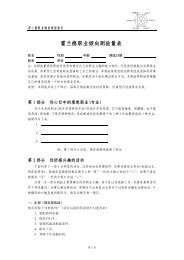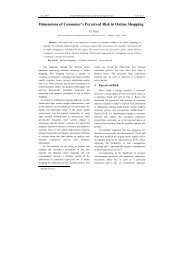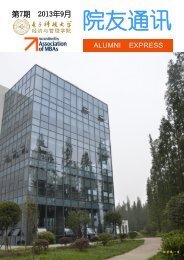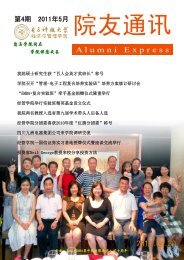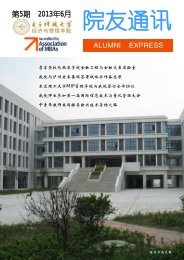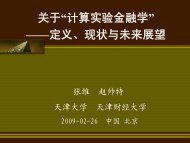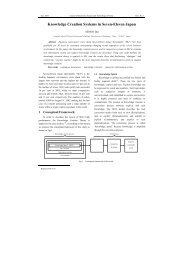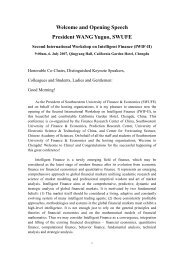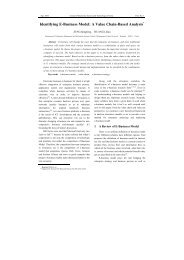from word document
from word document
from word document
You also want an ePaper? Increase the reach of your titles
YUMPU automatically turns print PDFs into web optimized ePapers that Google loves.
No.3 LI Mingzhi et al: Open Source Software Movement: A Challenging Opportunity for the Development of China’s Software Industry 49As for proprietary software, the value transfer<strong>from</strong> the producers to the users is partial, since theright to further exploit the software is retained by theproducers. While for OSS the situation is different.With the source code available free and the right tomodification, reuse and re-distribution of the software,not only can the users receive its value of application,but the professional users can also modify or enhancethe software for themselves. Fig.1 describes theprocess of value transfer of the two kinds of software.The characteristics of full value transfer whichgives users access to the working mechanism of thesoftware and permits modification, reuse andre-distribution of the software, makes OSS appealingto the Chinese government that wants to break thedominance of western software companies in theoperating system and applications market, helpingdomestic software industry growth.Contrast to the proprietary software, the intrinsicadvantage that OSS is a public good whose value couldbe fully transferred, serves one reason why the Chinesegovernment takes efforts to promote the developmentof OSS in China.3 The Software Industry in ChinaAnother reason for the Chinese government’spreference to OSS should be regarded with the currentstatus of the software industry in China. In recent twodecades, China’s high-tech industry has experiencedrapid development at a faster pace than the wholeeconomy, in which the software industry iscontributing increasingly more weight. In the past 10years, China’s software industry revenue has beengrowing at an annual rate between 20%~40%. Tab.1shows that China has a huge domestic market for thethree diversified software products.. In 2002, China’sapplication software accounted for 64.5% of the totaldomestic software products.Tab.1 The structure of software products in China (<strong>from</strong> 1992 to 2001)YearThe system software The maintenance software The application softwareRevenue(RMB10million) Proportion/(%)Revenue(RMB10million)Proportion/(%)Revenue(RMB10million) Proportion/(%)1992 1.6 8 5.4 27 12.8 651993 3.6 9 10.8 27 25.6 641994 4.5 9 13.2 27 31.3 641995 6.5 10 15.0 22 46.5 681996 8.5 9 20.0 22 63.5 671997 13.7 12 27.5 25 70.8 631998 17.4 13 35.9 26 84.7 611999 21.0 12 44.8 25 110.2 632000 33.2 14 49.6 21 155.0 652001 50.0 15 81.9 25 198.1 60Although China’s software industry has achieveda great success, there are still some major problems,which are becoming the obstacles in the path ofChina’s software industry development. We willanalyze these problems which may account for theChinese government’s promoting action on OSSmovement in three different levels: the industry level,the producer level, and the consumer level.3.1 Industry Level3.1.1 Analysis of StatusBelying the rapid growth, small scale and lowtechnology level tell the truth of China’s softwareindustry today. According to the Bulletin of ChinaSoftware Industry Association (2001), the total revenueof software in China only accounts for 1.5% of theworld’s total revenue of software in 2001. Furthermore,China’s software industry lacks senior professionals incore technology for the software. In 2002, of 59 000software personnel, 7% had Master degrees, 33% hadBachelor degree, and 17% had polytechnic degrees,and there were only 157000 research and developmentprofessionals scattered among 4 700 companies. On



